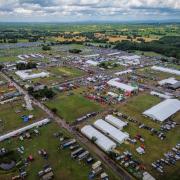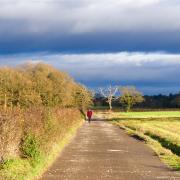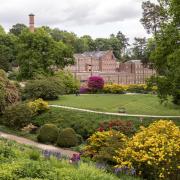Take a walk on the darkside through Chester’s past with Green Badge tourist guide David Atkinson.
I've always loved scary stories. From the Gothic literature of M.R. James to the film-noir vignettes of the TV series Inside Number Nine, I’ve been fascinated by tales from the dark side ever since I befriended the monsters under my bed as a child. That’s why, when I trained as a Green Badge Tourist Guide to Chester post-lockdown, I loved not only learning more about the rich heritage of my home city but also delving into the lesser-known folk tales and exploring the city’s lesser-visited alleyways. After all, Chester has 2,000 years of history, so imagine all the darkness as its fortunes ebbed and flowed over the centuries.
Once qualified last Easter, I launched my Dark Chester tour to shine a flickering candlelight into the darkest recesses of Chester’s heritage, revealing tales of plague, persecution, and poltergeists among others. It started as a one-off tour for the Chester Heritage Festival (CHF) but now runs all year round, Saturdays at 6pm, and attempts to answer some of our burning questions. For example, where does Satan reside in Chester? (The cathedral nave.) Why are we afraid of the antique dolls in the Dollectable shop on Lower Bridge Street? ([It’s called pediophobia.) And where did the great puppet show explosion of 1772 occur? (The southern side of Watergate Row.)

Dark Chester is a storytelling walking tour of the city tracing a journey through all periods of its history from the Romans to The Beatles. It highlights some of our lesser-known stories, such as tales of Viking Chester and the Anglo-Saxon fortification of Chester as a burh – a defended settlement. It also spotlights some of the more obscure figures from our history, such as Aethelflaed, the daughter of Alfred the Great, and St Werburgh, whose relics were said to be paraded around the city walls during raids by the Welsh.
The focus is dark history. By exploring the dark side, the tour reflects the growing interest in dark tourism, or visits to places associated with dark tales. As Dr Philip Stone of the Institute for Dark Tourism Research, explains in his book, 111 Dark Places in England that You Shouldn't Miss: 'Dark tourism allows us to sightsee in the mansions of the dead, while having deference to those deceased.'
So, what to expect? Here are some tales from the tour.

GALLOWS HUMOUR
The modern-day suburb of Boughton was home to Chester’s answer to Tyburn, namely the site of public execution. In reality, the gaol and gallows moved several times, the Boughton gallows finally abandoned after the botched execution of burglar John Clare in May 1801. Public executions moved first to the Northgate Gaol and then to the New City Gaol in 1808, where the Queen’s School stands today. Crowds of up to 2,000 people would gather along the city walls for executions at the latter, the dramatic crescendo relying on the theatrical ‘new drop’ gallows method, involving a scaffold and short flight of stairs.
In his book, A Vintage Casebook of Cheshire Crime, Derek Yarwood recounts the hanging of highwayman Thomas Brierley on September 14, 1822. Highway robbery, primarily of mail coaches, was rife around Chester in the early 19th century. Yarwood cites an entry from the Chester Chronicle newspaper, founded 1775, about how Brierley, a short man, was loaded with leg irons to accelerate the drop. It reports his body was 'much convulsed for about a minute and a half … when all motion ceased. Yet convulsive struggling again ensued — the hands tightly gripped — the chest heaved several times and the kneed were bent upwards.' The last women hanged in Chester was Alice Hewitt in 1863 and the last man Samuel Griffith, the latter convicted for murder of Isaac Newport in 1866. Both were executed at the New City Gaol while the UK’s final public execution was at London’s Newgate Prison in 1868.
PRESSED TO DEATH
We regularly visit St Mary On-the-Hill, now known as St Mary's Creative Space, as part of the tour. The church dates from around 1350 but hasn’t been a site of worship since the1970s, serving today as an arts centre for live-music and community events. I explain how the deep ditch between the church graveyard and Chester Castle was used a place for macabre, unmarked burials, including executed witches. It was also a place of burial for felons, tried at the Assizes (county court) at Chester Castle, who were condemned to be ‘pressed to death.’ St Mary's registers enter the names three such men, Tymothie Tatton (1616), William Wilson (1627) and Thomas Laceby (1631), who all met this gruesome fate.
If a prisoner refused to plead, then they avoided forfeiting any property to the Crown. But the ensuing torture was inhumane. The men would be stretched out, naked and on their backs, and wooden boards placed on top of them. The torturer would then place a series of stones and weights upon the wood over a course of hours. This continued, with two drinks of stagnant water allowed per day, until the prisoner either agreed to plead, or, as Roy Wilding describes in his book, Death in Chester, 'death released him from his sufferings'. That release sometimes took up to 48 hours.

PLAGUE AND PANDEMICS
Plague was, I explain, a regular visitor to Chester from the mid-1300s onwards, killing around one-third of Chester’s population during an outbreak from 1349-50. During later visits, Chester would have been stalked by plague doctors – physicians who wore a beak-like mask filled with aromatic herbs; find out more about them at the Sick to Death visitor attraction, located at St Michael's Church on Bridge Street. Unemployed men, meanwhile, became watchers for nightwalkers trying to escape confinement in plague-ridden houses and female searchers went into properties to find corpses, some robbing the dead and dying. Bellmen made an evening round to collect bodies for the plague pits, calling out, 'bring out your dead'.
Some savvy Cestrians made their own luck, however. To this day, God’s Providence House on Watergate Street, build 1652 and remodelled in the mid 1800s, bears the words, ‘God’s Providence is Mine Inheritance’. The phrase, a reference to the way the residents cheated death by locking themselves away with supplies to ride out the infection period, is clearly visible across the wooden beams as you sip one of 300-odd gins in what is now the Providence Gin bar. But don’t fear: it’s always darkest before the dawn. Chester’s fortunes, having hit a nadir during the Civil War siege of 1645-46, revived during the genteel Georgian period. The new General Infirmary opened in 1761, overlooking the city walks and racecourse beyond, and a forward-thinking young doctor, Dr John Haygarth, was appointed as its physician in 1767. By introducing a series of treatments, such as isolation wards and salt-water baths, he reduced smallpox deaths in Chester by almost half, notably amongst children. That’s why the latest blue plaque to be unveiled in the city celebrates the pioneering work of Haygarth — it's outside what is now known locally as the 1761 building.



























